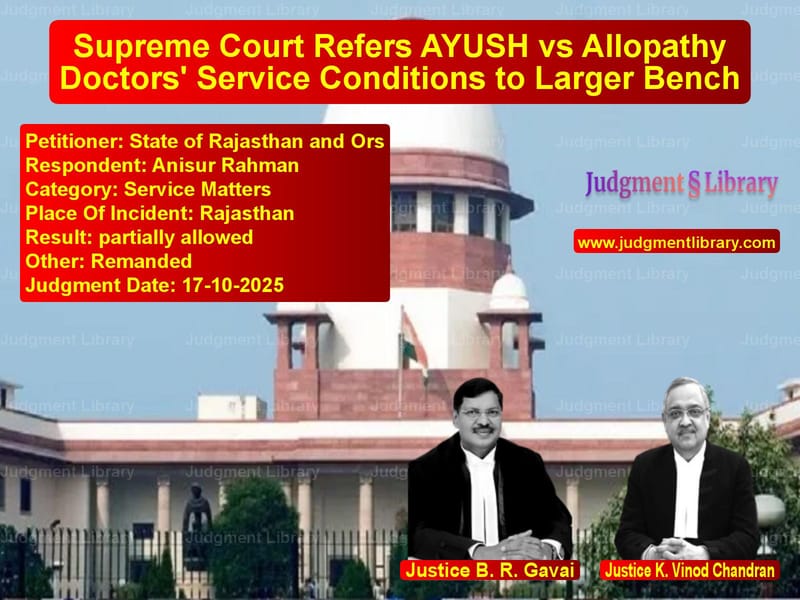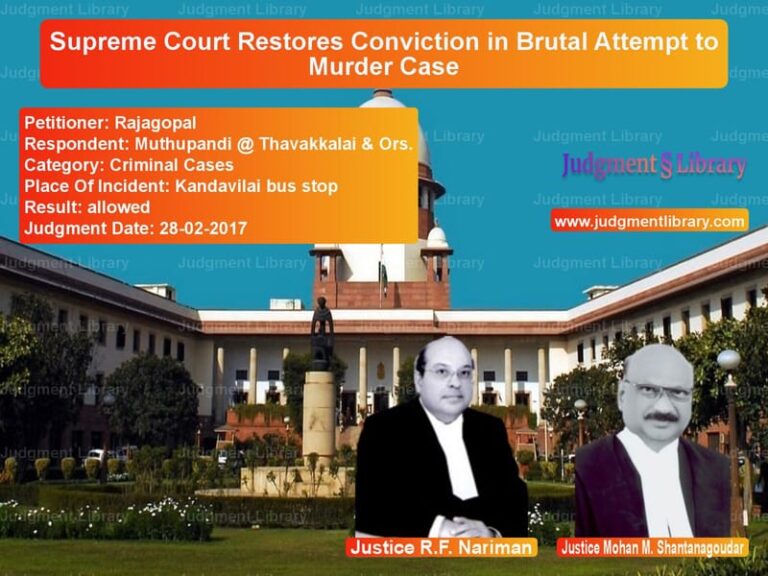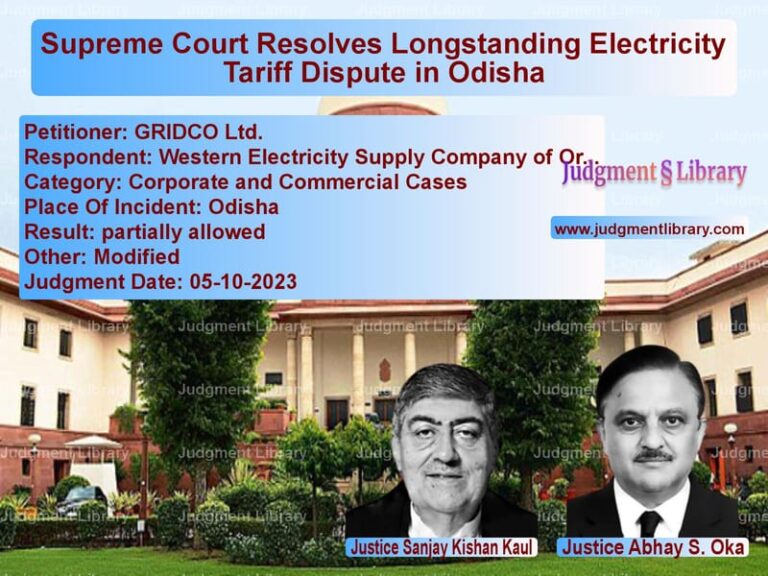Supreme Court Refers AYUSH vs Allopathy Doctors’ Service Conditions to Larger Bench
In a landmark development that could reshape the service conditions for medical practitioners across India, the Supreme Court has referred the contentious issue of parity between AYUSH and allopathy doctors to a larger bench. The case, which involves multiple special leave petitions from various states, centers around whether doctors practicing indigenous medicine systems like Ayurveda, Homeopathy, and Unani should receive the same retirement age and service benefits as their allopathic counterparts.
The legal battle has been brewing for years, with different Supreme Court benches taking varying positions on this complex issue. The current bench, comprising Chief Justice B.R. Gavai and Justice K. Vinod Chandran, acknowledged the conflicting precedents and the need for an authoritative pronouncement that would settle this matter once and for all.
The Core Legal Question
The Supreme Court framed the fundamental question at the heart of these petitions: ‘These Special Leave Petitions raise the question as to whether the doctors, practicing allopathy and indigenous medicine; like Ayurveda, Homeopathy, Unani etc. can be treated equally for the purpose of determining service conditions; herein, specifically retirement age.’
Read also: https://judgmentlibrary.com/supreme-court-resolves-telangana-judicial-service-recruitment-dispute/
The Court noted the conflicting precedents that have created legal uncertainty. In the case of New Delhi Municipal Corporation v. Dr. Ram Naresh Sharma & Ors., a Division Bench had found that AYUSH doctors and doctors under the Central Health Scheme could not be classified differently. The Court had observed: ‘This Court found that the AYUSH doctors and the doctors under the CHS cannot be classified in different categories since though practicing different forms of medicine; indigenous system and allopathy, they render the very same service to the patients, and any classification would be unreasonable and discriminatory.’
However, this position was later distinguished in State of Gujarat & Ors. v. Dr. P.A. Bhatt & Ors., where the Court took a different view. The Court explained the distinction: ‘The decision in Dr. Ram Naresh Sharma was distinguished on three grounds. One, that it was based on a decision of the Union Cabinet permitting those doctors under AYUSH also the higher retirement age, which direction came when the matters were pending before the Court. It was also held that the question of age of retirement stands on a different footing from the service conditions relating to pay and allowances and revision thereof.’
The Functional Distinctions
The Court extensively discussed the fundamental differences between allopathic and AYUSH practitioners, noting that these differences might justify different service conditions. The judgment highlighted: ‘It was found that allopathy doctors are required to perform emergency treatment and provide trauma care and assist in complicated surgeries none of which can be performed by doctors having a degree in indigenous systems.’
The Court further elaborated on these distinctions: ‘While holding that every alternative system of medicine has its own place of pride in history, the practitioners of indigenous system of medicine do not, in the present times, perform the complicated functions of a doctor having MBBS. The learned Judges also observed that the footfalls in Government Hospitals manned by MBBS doctors are far more than that in an institution administering treatment under the indigenous systems of medicine.’
The States’ Position
The Court considered the arguments put forward by various state governments defending the different retirement ages. The states contended that the enhancement of retirement age for allopathy doctors was necessitated by specific public health concerns: ‘We cannot ignore the submission of the States that enhancement of retirement age was only to ensure that there are sufficient experienced medical practitioners available to treat the public. The dearth of medical practitioners as occurring in allopathy does not exist in the indigenous systems of medicine especially when critical life-saving therapeutic, interventional and surgical care is not carried out by the practitioners of indigenous systems of medicine.’
The Court acknowledged the states’ concerns about maintaining sufficient numbers of qualified allopathy doctors: ‘The contention of the States which have brought in two different retirement ages, is also that of public good and the concern expressed is of dearth of sufficient allopathy doctors.’
The Need for Authoritative Pronouncement
Recognizing the conflicting judicial opinions and the complexity of the issue, the Supreme Court emphasized the need for a definitive ruling: ‘There is divergence of opinion insofar as whether the MBBS doctors and doctors practicing indigenous systems of medicine can be treated equally, for the purpose of service conditions, which on principle, it is trite cannot result in treatment of unequals as equals. We are of the opinion that there should be an authoritative pronouncement on the issue and we hence refer the matter to a larger Bench.’
The Court outlined the proper approach for evaluating claims of parity: ‘The claim for parity will have to be decided finally looking at the qualification acquired, the treatment practices, the functions, work and duties and so on.’
The judgment provided detailed reasoning for why allopathy doctors might constitute a distinct class: ‘The curriculum leading to the different qualifications, the dissimilar diagnostic methods, contrasting treatment philosophies and the disparate composition of medicines administered sets the allopathy doctors apart. Further, casualty, critical care, trauma management and the emergency interventional procedures are dealt with by allopathy doctors and not by AYUSH doctors. These aspects according to us, puts the former in a different class altogether, who can be classified differently for service conditions.’
Interim Arrangements
While referring the matter to a larger bench, the Supreme Court laid down interim arrangements to balance the interests of all parties. The Court directed: ‘In the meanwhile, the States and the authorities would be entitled to either continue the practitioners of indigenous systems of medicine, even after the age of superannuation specified for them till the age of superannuation provided for MBBS doctors, without the benefit of regular pay and allowances.’
The Court also provided for financial arrangements during this interim period: ‘Considering the fact that if the AYUSH doctors are continued, they will not be entitled to pension also, it is directed that they shall be paid half of the pay and allowances, which, if the reference does not yield any favourable orders will be adjusted in their pension or otherwise against the regular pay and allowances.’
The judgment also protected the rights of AYUSH doctors in case the larger bench rules in their favor: ‘Eventually, if the larger Bench holds in favour of the AYUSH doctors, entitling them for enhancement in retirement age, the practitioners would be entitled to avail pay and allowances during the period they were continued.’
Broader Implications
This reference to a larger bench represents a significant moment in Indian medical jurisprudence. The outcome will not only affect retirement ages but could potentially influence other service conditions, including pay scales, promotions, and working hours for thousands of medical practitioners across different systems of medicine.
The Court’s detailed analysis of the functional differences between medical systems provides a framework for future discussions about parity in the healthcare sector. The recognition that ‘every alternative system of medicine has its own place of pride in history’ while simultaneously acknowledging the distinct roles they play in contemporary healthcare delivery reflects a balanced approach to this complex issue.
The Supreme Court’s decision to refer the matter to a larger bench underscores the legal complexity and social significance of this issue. As healthcare systems evolve and integrate different medical traditions, this case will likely set important precedents for how India balances respect for traditional medical systems with the practical demands of modern healthcare delivery.
The final resolution by the larger bench will have far-reaching consequences for medical education, healthcare policy, and the professional lives of doctors across all systems of medicine in India.
Petitioner Name: State of Rajasthan and Ors.Respondent Name: Anisur Rahman.Judgment By: Justice B. R. Gavai, Justice K. Vinod Chandran.Place Of Incident: Rajasthan.Judgment Date: 17-10-2025.Result: partially allowed.
Don’t miss out on the full details! Download the complete judgment in PDF format below and gain valuable insights instantly!
Download Judgment: state-of-rajasthan-a-vs-anisur-rahman-supreme-court-of-india-judgment-dated-17-10-2025.pdf
Directly Download Judgment: Directly download this Judgment
See all petitions in Employment Disputes
See all petitions in Public Sector Employees
See all petitions in Pension and Gratuity
See all petitions in Judgment by B R Gavai
See all petitions in Judgment by K. Vinod Chandran
See all petitions in partially allowed
See all petitions in Remanded
See all petitions in supreme court of India judgments October 2025
See all petitions in 2025 judgments
See all posts in Service Matters Category
See all allowed petitions in Service Matters Category
See all Dismissed petitions in Service Matters Category
See all partially allowed petitions in Service Matters Category







